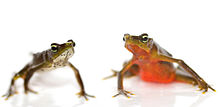- Sapo Limosa
-
Limosa Harlequin Frog 
Conservation status Scientific classification Kingdom: Animalia Phylum: Chordata Class: Amphibia Order: Anura Family: Bufonidae Genus: Atelopus Species: A. limosus Binomial name Atelopus limosus
Ibáñez, Jaramillo & Solís, 1995The Sapo Limosa, or Limosa Harlequin Frog (Atelopus limosus), is an endangered species of toad in the Bufonidae family. It is endemic to Panama and was described by Ibáñez, Jaramillo and Solís in 1995.[1]
Contents
Geographic range
Its natural habitats are stream banks in subtropical or tropical moist lowland forests and rivers of the Chagres watershed in central Panama.
Description
Atelopus limosus has two color forms. A lowland color form is brown with a yellow nose and finger tips, while the upland color form is green with black chevron markings on its back. Males and females of both color forms are sexually dimorphic. Males are smaller with a white belly speckled with black spots, while females tend to have a red or orange belly.
Little is known of their diet in the wild, but it is presumably similar to that of other Atelopus species that forage on beetles, ants, flies and mites.[2] In captivity the frogs readily accept large fruit flies, small meal-worm larvae and small crickets.
Conservation
Atelopus limosus is threatened by chytridiomycosis and habitat loss. Atelopus species have been rapidly declining throughout their range. 75% of all known species from highland sites above 1000 metres have disappeared, while 58% of lowland species have declined and 38% have disappeared.[3] Worried about the effects of chytridiomycosis on this endemic Panamanian frog, the Panama Amphibian Rescue and Conservation Project targeted Atelopus limosus as a priority rescue species to be taken into captivity as a captive assurance colony at the Summit Municipal Park in Panama City. When the rescue team arrived at one of the last known upland sites at Cerro Brewster, they found that many of the frogs were already infected with chytridiomycosis.[4] While the upland region seems to have been hard-hit by chytrid fungus, the fate of lowland populations of this species is uncertain, as chytridiomycosis appears to have more pronounced effects at upland sites.
Source
- ^ Solís, F., Ibáñez, R., Jaramillo, C. & Fuenmayor, Q. 2004. Atelopus limosus. 2006 IUCN Red List of Threatened Species. Downloaded on 21 July 2007
- ^ P Durant, JW Dole (1974) Food of Atelopus oxyrhynchus (Anura: Atelopodidae) in a Venezuelan cloud forest Herpetologica 30:183-187
- ^ Catastrophic Population Declines and Extinctions in Neotropical Harlequin Frogs (Bufonidae: Atelopus) Biotropica Volume 37 Issue 2, Pages 190 - 20
- ^ Panama amphibian rescue challenged by rapid spread of chytrid fungus
Categories:- IUCN Red List endangered species
- Atelopus
Wikimedia Foundation. 2010.


